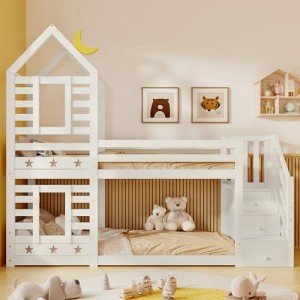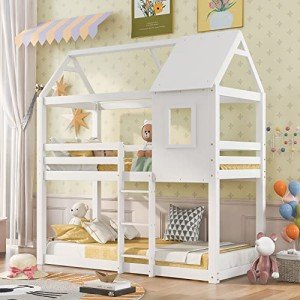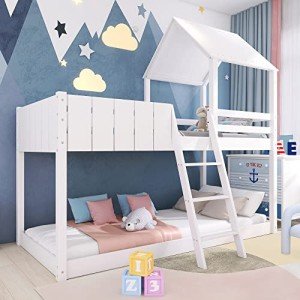Wooden bunk beds have become a popular choice among parents seeking efficient solutions for their children’s sleeping arrangements. Especially in rooms with limited space, bunk beds not only save floor area but also add an element of fun to a child's bedroom. However, safety should always be a priority when it comes to children's furniture. One of the best features to look for in a bunk bed is the presence of a ladder guard rail, which ensures secure access to the upper bunk while minimizing the risk of accidents. This guide will delve into the benefits, safety features, and considerations for selecting the perfect wooden bunk beds for children.
Benefits of Wooden Bunk Beds
Nothing quite matches the charm and durability of wooden furniture. Wooden bunk beds stand out for several reasons:
1. Durability and Strength
- Longevity: Wooden bunk beds are built to last. They can withstand the rigors of daily use and the energetic activities of kids, making them an excellent investment.
- No Toxic Chemicals: Many wooden bunk beds are made from natural materials, which are safer for children compared to some metal alternatives that may contain harmful chemicals.
2. Aesthetic Appeal
- Variety of Designs: Wooden bunk beds come in various styles, from classic to modern, allowing parents to choose designs that fit their home decor.
- Customizable Options: Many manufacturers offer customization options with different finishes and colors to match a child's personality and room theme.
3. Space-Saving Solutions
- Maximizes Floor Space: With the ability to fit two beds into the space of one, parents can use the extra room for play areas or study spaces.
- Multi-Functionality: Some models come with built-in storage solutions, such as drawers or shelves, providing added value.
4. Enhanced Safety Features
- Ladder Guard Rails: These are crucial in preventing falls, providing peace of mind for parents. A guard rail acts as a protective barrier when children are climbing up or down the ladder.
- Robust Construction: Quality wooden bunk beds are designed with safety in mind, featuring sturdiness that supports the weight of children without wobbling.
Features to Look For
When choosing a wooden bunk bed with a ladder guard rail, consider the following features for a safe and comfortable sleeping experience:
1. Quality of Material
Opt for beds made from solid wood, such as pine, oak, or birch, rather than engineered woods that may wear down faster.
2. Weight Capacity
Check the weight limits for the upper and lower bunk. Ensure the bed can comfortably accommodate children of varying sizes and weights.
3. Ladder Design
- Angle: A sloped ladder can be easier and safer for younger children to navigate compared to a straight ladder.
- Width: Wider rungs allow for better foot placement and stability.
4. Guard Rail Height
A higher guard rail offers better protection against falls. Make sure it has a height of at least 5 inches above the mattress level.
5. Assembly and Maintenance
Ease of assembly and the ability to disassemble the bed for relocation or storage are essential factors. Additionally, consider how easy it is to clean and maintain the wood finish.
Maintenance Tips for Wooden Bunk Beds
Regular maintenance ensures the longevity of a wooden bunk bed. Here are some tips:
- Clean Regularly: Use a soft, damp cloth to wipe down surfaces and avoid damaging the finish.
- Inspect for Wear: Routinely check for wobbly parts, loose screws, or cracks in the wood. Tighten screws and replace any damaged components immediately.
- Avoid Excessive Moisture: Keep the bed away from humid environments to prevent wood warping.
- Use a Mattress Protector: This adds an extra layer of protection against spills and accidents.
FAQs
1. Are wooden bunk beds safe for toddlers?
Yes, wooden bunk beds can be safe for toddlers when they include proper guard rails and are designed with safety features that cater to younger children.
2. Can I use a regular twin mattress on a wooden bunk bed?
Most wooden bunk beds are designed for standard twin mattresses. Always check the manufacturer's specifications to confirm the correct mattress size.
3. What age is appropriate for children to sleep in the top bunk?
Children aged 6 and older are generally considered appropriate for sleeping on the top bunk, as they possess the necessary coordination to use the ladder safely.
4. Do wooden bunk beds need to be assembled?
Yes, most wooden bunk beds require assembly. Many come with detailed instructions and all necessary tools for easy setup.
5. How much weight can a wooden bunk bed hold?
The weight capacity depends on the design and construction of the bed. Generally, a good-quality wooden bunk bed can hold between 200 to 400 pounds on the upper bunk.
Wooden bunk beds with ladder guard rails offer a delightful blend of functionality, durability, and safety for children's sleeping arrangements. With proper consideration of safety features, materials, and design, parents can find an ideal bed that meets their family's needs. By investing in quality wooden furniture, parents can transform a child's room into a safe and enjoyable environment while promoting better space utilization. When shopping for a bunk bed, keep these factors in mind, and children will be happily climbing into their cozy, safe sleeping spaces for years to come.
Comparison Table: Wooden Bunk Beds Features
| Feature | Description | Importance |
|---|---|---|
| Material | Solid wood vs. Engineered wood | Affects durability and safety |
| Weight Capacity | Upper/lower bunk limits | Ensures safety |
| Ladder Design | Slope, width, and grip of ladder | Enhances stability |
| Guard Rail Height | Minimum 5 inches above mattress | Prevents falls |
| Assembly | Ease of assembly and portability | User-friendly |
| Customization | Available colors and finishes | Matches room decor |
Incorporating these aspects will help parents navigate the world of children's furniture more effectively while prioritizing safety and functionality.






